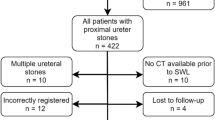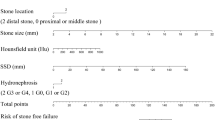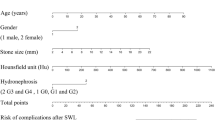Abstract
The purpose of this study was to design a thorough and practical nonlinear logistic regression model that can be used for outcome prediction after various forms of endourologic intervention. Input variables and outcome data from 382 renal units endourologically treated at a single institution were used to build and cross-validate an independently designed nonlinear logistic regression model. Model outcomes were stone-free status and need for a secondary procedure. The model predicted stone-free status with sensitivity 75.3 % and specificity 60.4 %, yielding a positive predictive value (PPV) of 75.3 % and negative predictive value (NPV) of 60.4 %, with classification accuracy of 69.6 %. Receiver operating characteristic area under the curve (ROC AUC) was 0.749. The model predicted the need for a secondary procedure with sensitivity 30 % and specificity 98.3 %, yielding a PPV of 60 % and NPV of 94.2 %. ROC AUC was 0.863. The model had equivalent predictive value to a traditional logistic regression model for the secondary procedure outcome. This study is proof-of-concept that a nonlinear regression model adequately predicts key clinical outcomes after shockwave lithotripsy, ureteroscopic lithotripsy, and percutaneous nephrolithotomy. This model holds promise for further optimization via dataset expansion, preferably with multi-institutional data, and could be developed into a predictive nomogram in the future.
Similar content being viewed by others
References
Cummings JM, Boullier JA, Izenberg SD, Kitchens DM, Kothandapani RV (2000) Prediction of spontaneous ureteral calculous passage by an artificial neural network. J Urol 164:326–328
Dwyer ME, Krambeck AE, Bergstralh EJ, Milliner DS, Lieske JC, Rule AD (2012) Temporal trends in incidence of kidney stones among children: a 25-year population based study. J Urol 188:247–252
Golden R (1997) Mathematical models for neural network analysis and design. Bradford Books, Bradford
Gomha MA, Sheir KZ, Showky S, Abdel-Khalek M, Mokhtar AA, Madbouly K (2004) Can we improve the prediction of stone-free status after extracorporeal shock wave lithotripsy for ureteral stones? A neural network or a statistical model? J Urol 172:175–179
Kalra P, Togami J, Bansal BSG, Partin AW, Brawer MK, Babaian RJ, Ross LS, Niederberger CS (2003) A neurocomputational model for prostate carcinoma detection. Cancer 98:1849–1854
Kanao K, Nakashima J, Nakagawa K, Asakura H, Miyajima A, Oya M, Ohigashi T, Murai M (2006) Preoperative nomograms for predicting stone-free rate after extracorporeal shock wave lithotripsy. J Urol 176:1453–1456 (discussion 1456–1457)
Michaels EK, Niederberger CS, Golden RM, Brown B, Cho L, Hong Y (1998) Use of a neural network to predict stone growth after shock wave lithotripsy. Urology 51:335–338
Niederberger CS (1995) This month in investigative urology. Commentary on the use of neural networks in clinical urology. J Urol 153:1362
Penniston KL, McLaren ID, Greenlee RT, Nakada SY (2011) Urolithiasis in a rural Wisconsin population from 1992 to 2008: narrowing of the male-to-female ratio. J Urol 185:1731–1736
Poulakis V, Dahm P, Witzsch U, de Vries R, Remplik J, Becht E (2003) Prediction of lower pole stone clearance after shock wave lithotripsy using an artificial neural network. J Urol 169:1250–1256
Preminger GM, Tiselius HG, Assimos DG, Alken P, Buck AC, Gallucci M, Knoll T, Lingeman JE, Nakada SY, Pearle MS, Sarica K, Turk C, Wolf JS Jr, American Urological Association Education and Research, Inc, European Association of Urology (2007) 2007 Guideline for the management of ureteral calculi. Eur Urol 52:1610–1631
Ramasamy R, Padilla WO, Osterberg EC, Srivastava A, Reifsnyder JE, Niederberger C, Schlegel PN (2013) A comparison of models for predicting sperm retrieval before microdissection testicular sperm extraction in men with nonobstructive azoospermia. J Urol 189:638–642
Sun CC, Chang P (2006) Prediction of unexpected emergency room visit after extracorporeal shock wave lithotripsy for urolithiasis—an application of artificial neural network in hospital information system. AMIA Annu Symp Proc 1113
Wickens TW (2001) Elementary signal detection theory. Oxford University Press, Oxford
Conflict of interest
The authors declare that they have no conflict of interest.
Author information
Authors and Affiliations
Corresponding author
Rights and permissions
About this article
Cite this article
Kadlec, A.O., Ohlander, S., Hotaling, J. et al. Nonlinear logistic regression model for outcomes after endourologic procedures: a novel predictor. Urolithiasis 42, 323–327 (2014). https://doi.org/10.1007/s00240-014-0656-1
Received:
Accepted:
Published:
Issue Date:
DOI: https://doi.org/10.1007/s00240-014-0656-1




